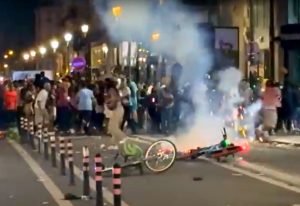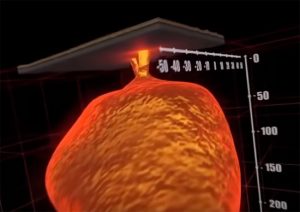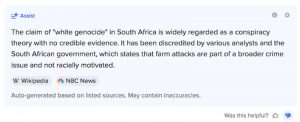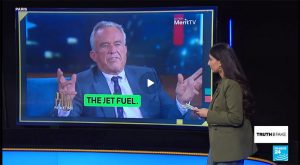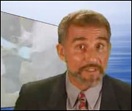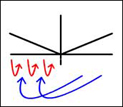A Summary of the History of the World, in Videos
THE EUROPEAN DARK AGES / MEDIEVAL PERIOD (410 AD — 1400 AD)
by Edward Ulrich, updated February 18, 2022
The videos on this page detail aspects of the European Dark Ages / Medieval period. It is a part of the article “A Summary of the History of the World, in Videos.”
After the fall of the Roman Empire starting in the 400’s, most of Europe was ruled by the feudal system where the countryside was a “patchwork quilt” of ever-changing kingdoms that were ruled by local kings and their vassals (such as lords, dukes, and knights.) Most Europeans lived as either impoverished peasants or “serfs” (who were similar to being a slave of their king in some respects), and most people were illiterate until the invention of the printing press in the 1,400’s.



This video explains the difficult lives of serfs during the Middle Ages. Serfs were similar to being slaves in some respects, where they were required to work for the lords who owned their land by growing food, and they were often required to be soldiers in wars for their kings.

This video talks about factors that made the lives of people be miserable during the Middle Ages. It talks about the Feudal System; the “Little Ice Age” happening between 1,300 and 1,500 AD; the Bubonic Plague decimating the population; the life expectancy of most people being only about 30 years old; the Catholic Church persecuting and taxing people; women having few rights and being considered to be the property of their fathers and husbands; medical knowledge being archaic and ridiculous; jobs in towns being difficult; people being forced to live under the rule of brutal and ridiculous arbitrary laws; and warfare constantly happening where people were expected to fight and die for their kings.
Videos on the Modern History TV channel detail aspects of Medieval life in Britain.




This video demonstrates the food that commoners ate during Medieval times in Britain. It explains that in some ways peasants ate better and healthier food than many higher status people did at that time. From the video: “Jason begins a journey through the social strata of the medieval age by taking a look at the kinds of food the knight might have experienced in his travels. He’s joined by food historian Chris Carr, who first demonstrates some of the dishes the knight might have eaten when staying at a humble roadside inn.”

From the video: “Stopping off at the farmhouse of one of his yeomen, the knight would experience more personal treatment and finer fare than at a poor roadside inn. Food historian Chris Carr takes Jason through the making of hot beans, bacon and leeks, pork in sage sauce and lamb pie, explaining how medieval pies differed from those we eat today.”

This video demonstrates the food that high status people ate during Medieval times in Britain. From the video: “A knight would often be expected to attend at a feast given by those of even higher standing than himself, perhaps a high ranking bishop or even the King. Food historian Chris Carr demonstrates the type of food the very wealthiest might bring out to entertain their noble guests. Jason draws some surprising conclusions at the end of his culinary journey through medieval society.”

This 2007 History Channel documentary talks about what happened between the fall of Rome in 410 AD and the Crusades starting in the 1000’s AD. It focuses on the conquests of Clovis to form the Franks and modern France; the rise of Christianity in Europe; the advent of the first bubonic Plague in 542 AD, killing up to 50% of the populations in urban areas of Europe; the invasion of Europe by Muslims in 732 which was rebuffed by Charles Martell in France at the Battle of Tours, saving Europe from becoming Islamic (and his grandson Charlemagne eventually becoming the Emperor of Rome); Charlemagne becoming the first Roman Emperor in 300 years at around the year 800, where he restored much of Europe to Roman control and brought health to the continent such as by instigating the education of the populace; the devastating Viking attacks in Europe between 793 and 950; King Alfred rebuffing the Vikings in southern England in the late 800’s; medieval knights starting to subjugate the populations of Europe starting in the 900’s; and the Crusades being undertaken in 1095.

This video details the “Battle of Tours,” which was one of the most important battles in European history. In 732 AD, a Frankish Mayor Charles Martel stopped an Islamic invasion into France, saving both his kingdom and Europe from being subjugated by Islam (as Spain was subjugated at that time.) [Note: Martel’s grandson Charlemagne eventually became the Emperor of Rome, with him often being thought of as “the father of modern Europe.”]

This video talks about how leftist bias in academia distorts people’s perception of the Battle of Tours. From the video page: “The importance of the battle at Tours in 732 A.D. is nowadays downplayed by many historians. According to them, Abdul Rahman’s invasion wasn’t really dangerous for Europe: either because it was merely an unimportant episode during the wars of European nobles against each other, or because it was only a ‘raid’ - a temporary incursion - , or because Muslim expansion had already ‘lost its momentum’ by the time of Tours, anyway. This video describes the battle and counters these views downplaying the battle’s significance.”

This documentary explains Rome being sacked by Arabs in 846. During the invasion, the people of Rome protected themselves by retreating behind the Aurelian Walls, leading to the raiders mostly only plundering churches on the outskirts of the city.

This video shows a timeline of battles fought and territory acquired by Islam from 620 - 1880 AD, and it also shows the same type of timeline for the Christian Crusades which lasted from 1080 - 1100 AD. It demonstrates that the Crusades were a relatively minor occurrence compared to the agressive Islamic expansion since Muhammad’s death.

In this 2012 video, David Wood explains that it is essential to understand the historical and modern stages of Islamic Jihad in order to understand 14 centuries of Islamic history and the situation the world is in right now. Wood explains an overview of the initial Jihads that happened during Muhammad’s life, and he details the specific circumstances behind earlier passages in the Quran which appear to preach a message of tolerance to non-Muslims.

This documentary talks about Scandinavian Vikings terrorizing people across Europe starting in 793, including taking slaves to be sold. It also talks about how they attacked York, England in 1066 and were rebuffed by King Herold.

This documentary details the Viking sack of Britain in 878, which was rebuffed by King Alfred.

This documentary details the Vikings discovering and settling in Iceland, Greenland, and North America starting in 800 AD. It describes Erik the Red settling Greenland in 982 AD; relations between the Vikings and the native Inuits who lived on the island; Leif Erikson discovering North America in 999 AD; how the Vikings were eventually driven out by the cooling climate of the “Little Ice Age” that started in the 1300s; and how the Black Death came to Greenland on its ships, decimating the populations of the people.

This PBS documentary shows a modern contest to make a working catapult that is capable of breaking castle walls.

This video on the Hull Museums channel demonstrates Medieval methods for creating pottery, including using a “stick wheel”-type pottery wheel that has similarities to ones used today.

From the video: “I attended a few days of 'medieval week' in Visby, Gotland, Sweden. One thing I did there was, with help, make a short rope. The fibre used was jute, which is not the most authentic medieval material for Sweden - jute is native to India - but at least it's vegetable fibre and not plastic. With the right equipment, making ropes is quite easy. Thanks to Stefan Blomgren for allowing me to make this video with him.”
[Note: I’m including these video in this section since these countries became established during this time after the fall of the Roman Empire.]




This video summaries the lengthy and turbulent history of France, from its founding as the Kingdom of the Franks in 481 AD after the fall of Rome, until the French de-colonized their holdings in Africa in the 1950’s.

This video explains the history of Britain since the islands were inhabited by people of the Beaker Culture thousands of years ago, up until modern times.

This video summarizes the lengthy history of Ireland from the Ice Age until today. Among the numerous events it mentions, it explains that the island’s monasteries became a center of Christian study after the fall of the Roman Empire, the island being colonized by Vikings, the Normans setting up rule on the island, Ireland becoming ruled by England in 1100’s and the wars and rebellions that followed over the next hundreds of years, the potato famine in the 1840’s that killed over a million people, and Ireland regaining independence in the 1800’s and 1900’s along with the conflicts that happened along with it. [Note: The video briefly mentions a pro-European Union stance, however note that there are many issues with the EU, as this video explains.]

This video shows the current state of medieval towns in Europe.

This documentary summarizes the intense regional activity that was happening throughout Europe at around 1000 AD.

This documentary explains Romania’s King who is known as “Vlad the Impaler,” who in the 1400’s defended his kingdom from being subjugated by Islam through using brutal types of psychological warfare, such as by impaling invading Muslims and plague victims on stakes along the path into the country.

This History Channel documentary details the Black Death Bubonic Plague that swept Europe between 1347 and 1351, being spread by fleas that traveled on rats that fed on grain stores.

This documentary summarizes the situation of the 100 Years War between England and France. It was caused by King Phillip VI of France claiming to be the legitimate ruler of France and Britain in 1328 due to being the first cousin of Charles IV who had no sons, while King Edward III of England also claimed to be the rightful heir due to being the son of Isabella of France, who was the daughter of Charles IV. The war ended with England and France having clearly defined national identities, followed by the “War of the Roses” soon being fought to determine who would control the throne of England.

This documentary details Briton’s bloodiest battle that killed 28,000 soldiers in one day during the “War of the Roses,” which was a war to determine who would control the throne of England. It shows skeletons being exhumed from mass graves, with many being shown to recieve horrific injuries in battle such as massive head wounds. The documentary also recreates what one of the combattants looked like based on his skull.
<< previous section | next section >>
Article Tree
| A Summary of the History of the World, in Videos |
| THE EUROPEAN DARK AGES / MEDIEVAL PERIOD (410 AD — 1400 AD) |


